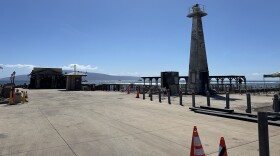Two years after the 2023 Maui fires, there’s a continued effort to manage invasive grasses that can fuel and spread wildfires.
Non-native and fire-prone grass species, such as buffel or guinea grass, continue to be an issue on the island, and there’s been an ongoing drive to manage them and prevent larger wildfires that grow and move with high winds and flammable plants.
One of the state’s top methods for controlling fire-prone plants on Maui is to make breaks in dry grasses that can otherwise serve as highways for wildfires.
A popular method for making fuel breaks is fencing off areas of the dry grass and using grazing animals to eat — and manage — them.
“The plan is to work with local livestock owners who are already looking for grazing land. … In exchange their animals are going to keep those invasive grasses nice and short,” said Abraham Puz, a protection forester with the state Department of Land and Natural Resources’ Division of Forestry and Wildlife. “So if a fire does come there, it's going to slow down, we're going to be able to catch it, we're going to get helicopters to it.”
Puz said crews have also been trying to harden state land by removing the invasive grasses, and replacing them with native, less flammable plants like wiliwili and kukui trees.
The focus is on keeping fires from reaching people and communities, and areas where wildfires have been a problem historically.
Some areas where work has been done include the Kamehamehanui Forest Reserve in upcountry, Pōhākea in central Maui, and Olowalu on the west side.
In a 200-acre plot of state land in Pōhākea that burns regularly, Puz said the state made grazed fuel breaks and installed fencing and irrigation to mitigate the potential for fires.
“We're putting enclosures where we can get some native species, which … didn't evolve in a fire ecosystem like some of the areas in the mainland. So the native plants we plant are all going to make the landscape more resistant to fire,” Puz said.
He added that dip tanks and reserve tanks of water are being installed in the area so helicopters have easy access to water during fires.
Meanwhile, groups like the Maui Invasive Species Committee are focused on preventing other fire-prone invasive species from becoming established in the first place.
Two ornamental grass species are at the top of MISC’s list.
The drought-tolerant fountain grass is widespread on Hawaiʻi Island, said Lissa Strohecker, MISC’s public relations and education specialist, but can easily make its way to Maui. It’s not established on Maui, though sometimes patches emerge.
The other species is pampas grass, which is already growing on the west side of Maui.
“Our footprint for pamas grass where we're looking for and trying to remove it is about 27 square miles — it's scattered in that area,” Strohecker said, adding that West Maui is “a very large aquifer and critical for water supply as well as all the native species … that are on the brink of extinction. And then you're introducing a wildfire fuel.”
Strohecker is urging the public not to use either for landscaping.
She said gardeners can refer to the Plant Pono website to look up the likelihood that a plant will become invasive.
Puz said the work to manage flammable grasses on Maui will require a continued effort.
“I don't foresee a point where I'll look at it and be like, ‘I think every forest reserve, every parcel is 100% protected and there’s no way to improve it. … We'll always look to improve, just because of how unpredictable fire can be,” he said.








